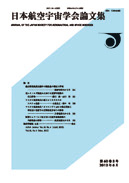All issues

Volume 31, Issue 354
Displaying 1-7 of 7 articles from this issue
- |<
- <
- 1
- >
- >|
-
Tatsuzo OBAYASHI1983Volume 31Issue 354 Pages 337-344
Published: July 05, 1983
Released on J-STAGE: May 25, 2009
JOURNAL FREE ACCESSDownload PDF (5051K) -
Hiroshi KOBAYASHI1983Volume 31Issue 354 Pages 345-353
Published: July 05, 1983
Released on J-STAGE: May 25, 2009
JOURNAL FREE ACCESSDownload PDF (5584K) -
Keiji KOMATSU, Masaaki SANO1983Volume 31Issue 354 Pages 353-362
Published: July 05, 1983
Released on J-STAGE: January 13, 2010
JOURNAL FREE ACCESSDownload PDF (1264K) -
1983Volume 31Issue 354 Pages 363-366
Published: July 05, 1983
Released on J-STAGE: May 25, 2009
JOURNAL FREE ACCESSDownload PDF (821K) -
Potential Flow Field around a Lifting Wing by Use of the Surface Velocity ComponentsMasao EBIHARA1983Volume 31Issue 354 Pages 367-376
Published: July 05, 1983
Released on J-STAGE: May 25, 2009
JOURNAL FREE ACCESSAn integral equation of the second kind for the surface velocity components of the incompressible three-dimensional potential flow around a body is obtained by extending the procedure explored by W. PRAGER, F. VANDREY and E. MARTENSEN in two-dimensional situations. The formulation is based on the representation of the velocity potential by a doublet distribution over the body surface, and is realized by replacing the original body-surface boundary condition of vanishing normal velocity component with the equivalent condition of a quiescent flow in the region inside the body. The equation is then generalized to cases where the prescribed normal velocity component to the body surface does not necessarily vanish identically.
As a prerequisite of dealing with the flow around a lifting wing, the implication of the KUTTA condition within the present formulation is studied by examining the behaviour of the derived integral equation at the sharp trailing edge of a wing. It is found that the geometry of the trailing vortex sheet and the direction of vortex-shedding in the immediate neighbourhood of the trailing edge bear an essential relation to the fulfilment of the condition. In this context, the present formulation needs a more elaborate representation of the trailing vortex sheet than envisaged by the classical PRANDTL's model.View full abstractDownload PDF (664K) -
Hideo MATSUO, Kensuke MATSUO1983Volume 31Issue 354 Pages 376-384
Published: July 05, 1983
Released on J-STAGE: May 25, 2009
JOURNAL FREE ACCESSA quasi-static non-linear analysis of the cushion stability of ACV in vertical motion is reported. The analysis includes the consideration of the effects of fan, ducting and powerplant characteristics as well as the cushion characteristics. The forced oscillation test of an ACV model was carried out. The results of the analysis were compared with the experiments and they agreed well with the experiments in so far as the present model tests were concerned.View full abstractDownload PDF (539K) -
Tamotsu SAKAMOTO1983Volume 31Issue 354 Pages 384-393
Published: July 05, 1983
Released on J-STAGE: May 25, 2009
JOURNAL FREE ACCESSA novel navigation algorithm using a tree search procedure developed in Artificial Intelligence has been proposed for both the air-toair combat between fighter planes and the approach of missiles to air-targets. This algorithm is much easier with respect to the mathematical treatment of the nonlinearity of system equations and the boundary conditions than the differential game method. And it takes much more account of the reciprocal action between a pursuer and a evader than the usual navigation algorithm such as proportional navigation, pure pursuit and so on, by means of AND/OR game tree search which is much more efficient than the pure minimax procedure. This paper presents a comparison between the navigation algorithm using the game tree and the pure pursuit which is often adopted especially in air-to-air combat simulation models, and shows a difference between the shallow tree search navigation algorithm and the deep one, by use of a very simple air-to-air combat model.View full abstractDownload PDF (526K)
- |<
- <
- 1
- >
- >|